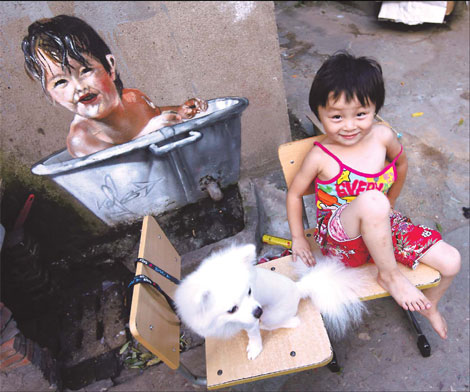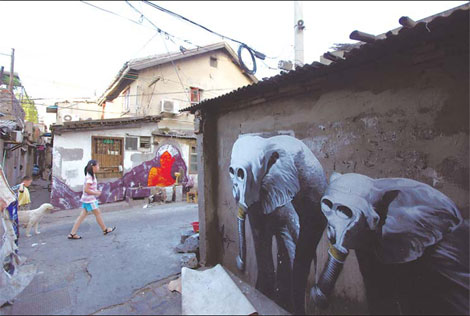 |
Large Medium Small |
|
 Zhao Jingjing, and her neighbor's pet, sit in front of a graffito of herself taking a bath in an old tin tub. Photos by Gao Erqiang / China Daily
|
A group of German graffiti artists have sprayed the walls of a traditional Shanghai neighborhood as part of the Expo celebrations, Shi Yingying reports
Three-year-old Zhao Jingjing became the star of No 211 nongtang in Huachi Road, where she has lived since birth, when media flocked to the lane to photograph her posed in front of the graffito of herself taking a bath in an old tin tub painted on the wall of her house.
The 60-year-old Shanghai nongtang, a lane full of vegetable peddlers and outdoor tailors, is now decorated with western-style graffiti courtesy of a group of German graffiti artists.
"It was a gift to the locals," says German graffiti artist Jens Muller - who goes by the tag Tasso. "Local residents invited me for lunch to say 'thank you'. It was great to see them happy."
Akim Walta, the project coordinator, Jens Muller and four other artists came to Shanghai in the middle of May for an urban art project at the invitation of the Expo's German Pavilion.
However, due to the loose schedule, they had time on their hands.
"One day, I passed Huachi Road and that's where I got my first impression of a local Chinese neighborhood - far away from the skyscrapers. I had the idea to paint something in such a place," Muller says.
In Germany, varied kinds of graffiti cover the surface of many public spaces, with teenagers going out at night to illegally paint on buildings and trains, but "to paint on a private house is unusual, except when the house owner orders it and pays for it", Muller told China Daily.
"In Shanghai, we fascinated the (local) people, so we got the opportunity to paint our ideas for free on their houses."
A baby in a bathtub, elephants with rubber tubes on their noses, a Chinese dragon and phoenix, the colorful graffiti is a delight to residents living in the houses.
"Though I don't know much about art, I'm in love with these. Especially the one across my door," says Xu Yan who lives at one end of the lane and pointed to a girl with curly hair. "Don't you think it's such a nice and timeless present?"
|
 Two elephants with rubber tubes on their noses painted on a wall at No 211 nongtang in Huachi Road. |
"I would say the young people really appreciate this new art form and even the older people in China are much more open than in our country," says 40-year-old Walta, who is also the founder of street cultural base, Hip Hop Stutzpunkt, in Berlin.
Graffiti has been controversial since it first appeared in the late 1960s in New York City and the neighborhood committee of Tielu residential community, which is in charge of the lane's public order, was quick to react and try to remove the graffiti.
"We worried about the negative impression on the city," says a neighborhood committee official surnamed Lu.
At the end of May, workers sent by the neighborhood committee started erasing the graffiti, but were stopped by local residents.
"I like it and don't want the art piece on my wall to be covered by cement," says resident Chen Jisheng, who called Shanghai TV and saved the street art.
Walta can't thank his local friends enough, "the (local) kids placed themselves like a shield in front of the paintings and protected them so nothing could be destroyed."
Later this month the German graffiti artists will be back for the German Pavilion's Wall Lords project. Anja Goette, culture program manager of Germany Pavilion, says this kind of street art is preferred by Expo-goers.
"Compared to a concert that requires hour-long concentration, the public street event in front of the German Pavilion is eye-catching," says Gottee. "At the same time, it suits the Expo theme of a 'Better City Better Life', as street culture is a big part of urbanization."
For the German artists, painting on the walls of Shanghai's lanes means a part of themselves will always stay with the locals.
"A painting on canvas is transportable and you can take it everywhere. But those paintings will stay in the area with the people," Muller says.